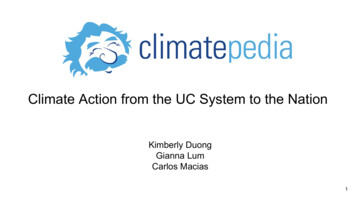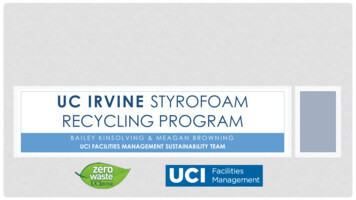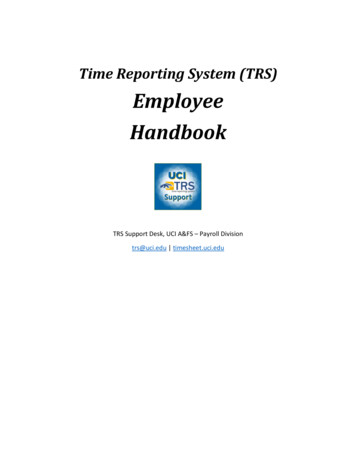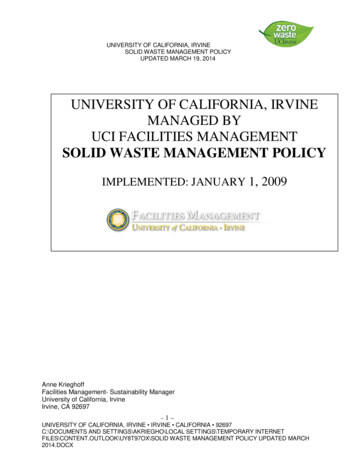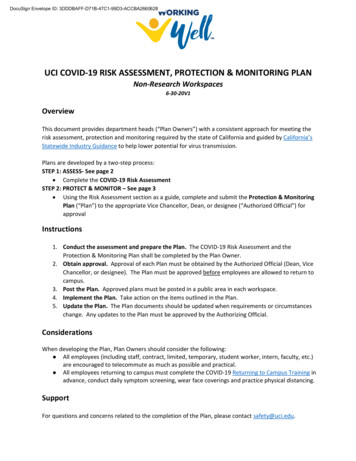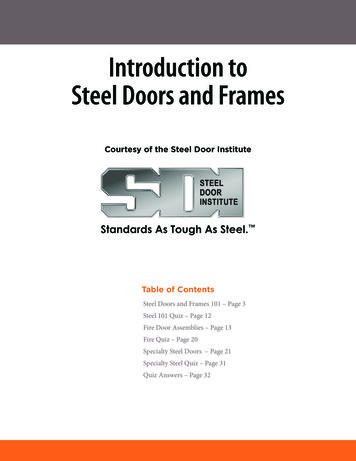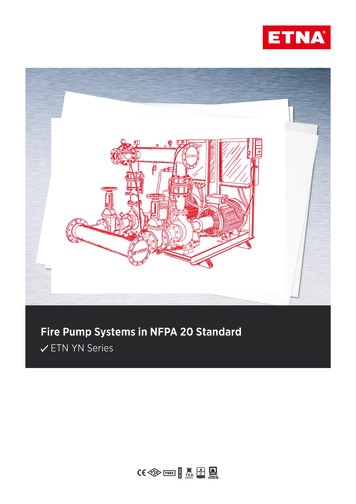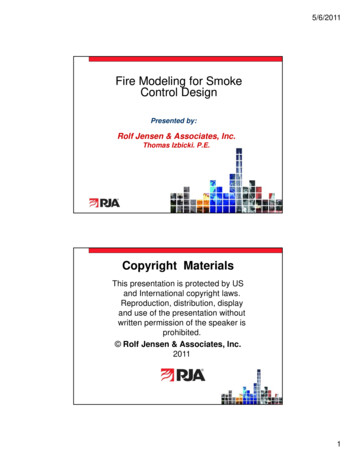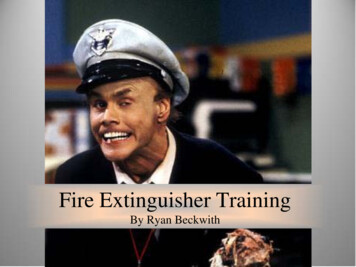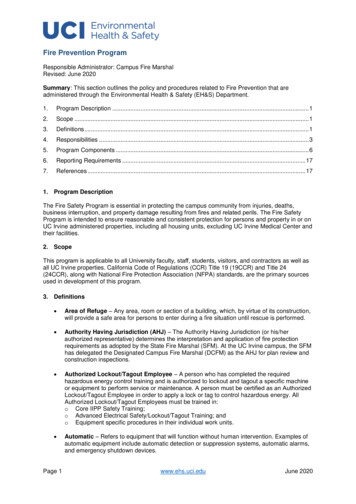
Transcription
Fire Prevention ProgramResponsible Administrator: Campus Fire MarshalRevised: June 2020Summary: This section outlines the policy and procedures related to Fire Prevention that areadministered through the Environmental Health & Safety (EH&S) Department.1.Program Description . 12.Scope . 13.Definitions . 14.Responsibilities . 35.Program Components . 66.Reporting Requirements . 177.References . 171. Program DescriptionThe Fire Safety Program is essential in protecting the campus community from injuries, deaths,business interruption, and property damage resulting from fires and related perils. The Fire SafetyProgram is intended to ensure reasonable and consistent protection for persons and property in or onUC Irvine administered properties, including all housing units, excluding UC Irvine Medical Center andtheir facilities.2. ScopeThis program is applicable to all University faculty, staff, students, visitors, and contractors as well asall UC Irvine properties. California Code of Regulations (CCR) Title 19 (19CCR) and Title 24(24CCR), along with National Fire Protection Association (NFPA) standards, are the primary sourcesused in development of this program.3. Definitions Area of Refuge – Any area, room or section of a building, which, by virtue of its construction,will provide a safe area for persons to enter during a fire situation until rescue is performed. Authority Having Jurisdiction (AHJ) – The Authority Having Jurisdiction (or his/herauthorized representative) determines the interpretation and application of fire protectionrequirements as adopted by the State Fire Marshal (SFM). At the UC Irvine campus, the SFMhas delegated the Designated Campus Fire Marshal (DCFM) as the AHJ for plan review andconstruction inspections. Authorized Lockout/Tagout Employee – A person who has completed the requiredhazardous energy control training and is authorized to lockout and tagout a specific machineor equipment to perform service or maintenance. A person must be certified as an AuthorizedLockout/Tagout Employee in order to apply a lock or tag to control hazardous energy. AllAuthorized Lockout/Tagout Employees must be trained in:o Core IIPP Safety Training;o Advanced Electrical Safety/Lockout/Tagout Training; ando Equipment specific procedures in their individual work units. Automatic – Refers to equipment that will function without human intervention. Examples ofautomatic equipment include automatic detection or suppression systems, automatic alarms,and emergency shutdown devices.Page 1www.ehs.uci.eduJune 2020
California Building Code (CBC) – Part of 24CCR, Part 2, “California Building StandardCode,” as defined in the “California Building Standard Law”, commencing with Section 18901in the California Health and Safety Code. California Fire Code (CFC) – Part 9 of 24CCR. Campus Fire Marshal (CFM) – The CFM is a campus representative who has theresponsibility and authority to enforce fire and life-safety requirements in all UC Irvinefacilities. Combustible Material – This term applies to solid materials that are capable of igniting andburning. Combustible Liquid – Liquids with a flash point of 100 Fahrenheit or above, which arecapable of ignition and require a higher degree of heat to produce a fire. Designated Campus Fire Marshal (DCFM) – At the UC Irvine campus, the SFM hasdelegated the Designated Campus Fire Marshal (DCFM) as the AHJ for plan review andconstruction inspections. The DCFM also has the responsibility and authority to enforce SFMregulations and requirements on campus. Exit – The portion of a means of egress that is separated from all other spaces of the buildingto provide a protected way of travel to the exit discharge. Exit Discharge – A means of egress that is separated between the termination of an exit anda public way. Emergency Device – A general type of emergency safety device or equipment. This mayinclude items such as fire alarm pull stations, fire extinguishers, fire alarms, smoke detectors,fire hydrants, and fire department connections. Fire Compartment – A space within a building that is enclosed by fire barriers on all sides(including the ceiling and floor), which will withstand the passage of fire and/or smoke for alimited time. Fireworks – Any device containing chemical elements and chemical compounds capable ofburning independently of the oxygen of the atmosphere, and producing audible, visual,mechanical, or thermal effects which are useful as pyrotechnic devices or for entertainment. Flammable Liquid – A liquid that has a flash point of less than 100 Fahrenheit and will igniteat a low temperature and continue to burn. Hazardous Products/Area – A flammable, combustible, toxic, corrosive, noxious, heatproducing product or appliance which could cause ill effects to humans if released in anuncontrolled amount or manner. A hazardous area is any room or structure in which theseproducts are processed, stored or used. Listed – All equipment or materials that are accepted by the SFM as conforming to theprovisions of the SFM’s regulations and are included in a list published by the SFM. Luminaries – Objects or bodies that emit or reflect light while creating a bright and lightedarea. Means of Egress – The direction or way a person would evacuate a building in anemergency. National Fire Protection Association (NFPA) – A nationally recognized fire protectionassociation that develops fire protection codes and standards.Page 2www.ehs.uci.eduJune 2020
Occupant Load – The maximum number of people which can occupy any given space withsufficient room to move about, complete a function, and/or safely evacuate the building. Pyrotechnics – Any combination of materials, including pyrotechnic composition, which, bythe agency of fire, produce an audible, visual, mechanical or thermal effect designed andintended to be useful for industrial, agricultural, personal safety, or educational purposes. Theterm “pyrotechnic device” includes, but is not limited to, agricultural and wildlife fireworks,model rockets, exempt fireworks, emergency signaling devices, and special effects. Self-closing – A device which will ensure that a door or required enclosure will, whenopened, return to the closed and latched position without human intervention. Surge Protector – A listed multi-plug extension cord device which incorporates an on/offswitch, built-in fuse, and is Underwriter’s Laboratory (UL) or Factory Mutual (FM) tested. Title 19 (19CCR) – Contained as part of Division I State Fire Marshal Regulations, PublicSafety. Title 24 (24CCR) – Contained as part of the California Building Standard Codes. There are11 parts to this Code (http://www.bsc.ca.gov/Home/Current2013Codes.aspx ):o Part 1 – California Administrative Code (CAC)o Part 2 – California Building Code (CBC)o Part 3 – California Electrical Code (CEC)o Part 4 – California Mechanical Code (CMC)o Part 5 – California Plumbing Code (CPC)o Part 6 – California Energy Codeo Part 7 – California Elevator Safety Construction Codeo Part 8 – California Historical Codeo Part 9 – California Fire Codeo Part 10 – California Code for Building Conservation Part 12 – California ReferencedStandards Code4. Responsibilities Page 3The Chancellor has ultimate responsibility for the campus and designates appropriateresources for campus safety and fire protection.The Vice Chancellors are responsible for ensuring that all units under their direction areaccountable for specific and applicable elements of the Fire Safety Program.The Deans, Department Heads, and Department Chairs are responsible for ensuring that allproposed facilities, facility alterations/remodels, operations, apparatus, equipment, andhazardous materials within their area of responsibility are reviewed for compliance to allapplicable protection requirements and by the Campus Fire Marshal (CFM).Within EH&S and the Fire Safety Division, the Designated Campus Fire Marshal (DCFM), inaccordance with a negotiated MOU between the SFM’s office and the University of California,carries out plan review and construction inspections for the Irvine campus and all facilitiesthat are regulated by the SFM. The DCFM is designated as the AHJ in the interpretation andapplication of fire protection codes and regulations and is authorized to enforce applicable fireand life-safety codes, laws, and regulations for all construction projects on campus, and in UCIrvine facilities. The DCFM is authorized to suspend unsafe construction operations orconstruction activities, and has the responsibility for ensuring compliance with all fireprotection requirements, including, but not limited to:o The review and approval of all campus construction and alteration plans andspecifications including fire protection and alarm systems, buildings, structures, andutilities.o The inspection of all campus construction projects prior to use or occupancy.o The issuance of “stop orders” when construction work is done contrary to the provisionsof the building or fire protection codes, standards, or regulations.o Submittal of quarterly reports to the SFM.www.ehs.uci.eduJune 2020
Within EH&S and the Fire Safety Division, the Campus Fire Marshal (CFM), is responsible forthe interpretation and application of fire protection codes and regulations, and is authorized toenforce applicable fire and life-safety codes, laws, and regulations, in UC Irvine facilities. TheCFM has responsibility for ensuring compliance with all fire protection requirements including,but not limited to:o The storage, handling and use of explosive, flammable, combustible, toxic, corrosive, andother hazardous materials.o The maintenance of exits, fire resistive construction and assemblies, fire alarm systems,and fire extinguishing systems and equipment.o The prevention and elimination of fire, life-safety, and panic hazards. The Deputy Director, Environmental Health and Safety (EH&S), in conjunction with theCampus Fire Marshal, is responsible for hazardous materials management, including spillresponse. The Deputy Director, EH&S and CFM interprets the requirements placed upon theUniversity of California by the State of California for the operation of the campus and strivesto implement and enforce the Campus Fire Safety Program.The Associate Vice Chancellor (AVC) of Design and Construction Services (D&CS) has theauthority, powers, and duties of a Building Official as described in the California BuildingCode (CBC), and is responsible, in conjunction with the DCFM, for assuring compliance withall fire protection requirements pertaining to the design, erection, construction, enlargement,alteration, repair, moving, removal, demolition, conversion, occupancy, equipment, and use ofall campus buildings, structures and utilities. The Building Official, in conjunction with theDCFM, is authorized to issue “Stop Orders” when work is being done contrary to theprovisions of the CBC or any other adopted fire protection code, standard or regulation.The AVC of Facilities Management (FM) is responsible for working with the Deputy Director,EH&S and the CFM for maintaining fire alarm and extinguishing systems in accordance withadopted California state and national fire codes and standards. The AVC of FM is alsoresponsible for the Campus grounds management program which addresses fire hazardreduction and abatement.The Chief of University Police is responsible for ensuring compliance with nationallyrecognized standards and practices pertaining to the facility, operations and maintenance ofan Emergency Communications Dispatch Center for efficient, safe and rapid dispatch ofemergency response units.The AVC of Housing is responsible for working with the Deputy Director, EH&S and the CFM,and for ensuring that residential students, staff and employees are provided with required fireand life-safety training and education to maintain awareness of fire safety practices,emergency procedures and recognition of unsafe acts or unlawful acts. The AVC of Housingis also responsible for ensuring that all fire protection and life-safety systems under his or hercontrol are properly maintained in accordance with adopted California state and national firecodes and standards.Deputy Director, EH&So Provide and maintain necessary fire protection staff and resources to develop andmaintain the Campus Fire Safety Program.o Minimize the potential for the occurrence of fire or related perils.o Strive to ensure the safety of UC Irvine employees, staff, students, and faculty in theevent of fire or related perils.o Ensures CFM’s have support, training, and resources to implement the Fire PreventionProgram elements.Fire Safety Divisiono Responds to fire-related emergency calls received by the Emergency Dispatch Center.o Coordinates fire-related emergency response activities, procedures and protocol withlocal fire agencies.o Coordinates investigations with SFM/Cal Fire for the cause, origin and circumstances offires and explosions.o Coordinates with local fire agencies on Pre-Incident Plans to ensure that properfirefighting tactics and strategies are employed at designated target hazards on campus.o Reviews tests for fire hydrant systems.o Trains campus employees, staff, faculty, and students in fire and life-safety and fireextinguisher operation. Page 4www.ehs.uci.eduJune 2020
ooooooooAssists departments with emergency evacuation drills.Responds to requests from Child Care Services to conduct fire safety inspections of childcare units in accordance with the Child Care Services Safety Inspection Program.Reviews tests and inspections of all fire protection suppression systems and standpipesin accordance with 19CCR.Reviews tests and inspections of all campus fire pumps, underground street valves andpressure reducing valves in accordance with NFPA 25.Reviews tests for fire alarm systems, fire suppression systems, portable fireextinguishers, all campus fire alarm systems testing reports including, but not limited to,automatic and manual initiating devices, flow and tamper switches, horns and/or bells,circuitry, supervisory and monitoring panels, and devices in accordance with frequencyand procedures as prescribed in NFPA 72.Provides periodic reviews of buildings to verify types of fire extinguishers and theirlocations.Provide general oversight on all state and non-state funded buildings for the following firesafety issues: Evacuation Plans Fire extinguishers Fire Hydrants Fire SprinklersThe Fire Safety Division also assists Facilities Management by serving as a technicalresource for the aforementioned fire safety issues. Environmental Health & Safety (EH&S)o Reviews and inspects campus operations and activities and refers observed fire safetyviolations to the CFM for corrective action.o Responds to hazardous materials spills and/or releases to manage, control and mitigatethe incident to a safe condition as determined by local responding agencies.o Conducts fire and life-safety inspections of campus buildings, facilities and laboratories. Design and Construction Services (D&CS)o Develops, maintains, and ensures compliance with UC Irvine Campus Standards andDesign Criteria Manual (http://www.ucop.edu/facil/fmc/facilman/).o Ensures all campus construction projects comply with all applicable fire and life-safetyregulations including, but not limited to, fire department access, fire flow requirements,exiting, fire-resistive construction, and fire suppression and alarm systems.o Ensures that all campus projects are approved by the DCFM prior to construction oralteration.o Ensures that all campus construction projects are inspected and approved by the DCFMprior to use or occupancy. Facilities Management (FM)o Inspects, tests and maintains all campus fire alarm systems including, but not limited to,automatic and manual initiating devices, flow and tamper switches, horns and/or bells,circuitry, supervisory and monitoring panels, and devices in accordance with frequencyand procedures as prescribed in NFPA 72.o Ensures that campus construction projects are approved by the DCFM prior toconstruction or alteration.o Ensures that all campus construction projects are inspected and approved by the DCFMprior to use or occupancy.o Inspects and maintains campus exit signs, emergency lights, and stand-by generators inaccordance with the frequency and procedures as prescribed in CBC.o Maintains all campus fire mains, fire pumps, water tanks, underground street valves, andpressure- reducing valves in accordance with NFPA 25.o Maintains all fire protection suppression systems, fire hydrants, and standpipes inaccordance with 19CCR.o Maintains campus fire access ways to permit fire engine access in undeveloped areas.Page 5www.ehs.uci.eduJune 2020
Housing and Dining Serviceso Provides fire safety and emergency notices, information, literature, and/or flyers tostudent residents and housing staff.o Conducts fire safety inspections of residential units in accordance with the HousingService’s Residential Safety Inspection Program.o Coordinates fire evacuation drills and exercises annually with the Fire Safety Division.o Ensures training for residential and maintenance staff in fire safety and fire extinguisheruse. Insurance and Risk Managemento Serves as liaison with insurance carrier(s) relating to fire safety issues in consultation withCFM.o Participates in selected fire safety and hazard assessments inspections and developsrecommendations to mitigate or reduce University liability risks. Child Care Serviceso Works with the Fire Safety Division to conduct fire safety inspections of child care units inaccordance with the Child Care Services Safety Inspection Program.o Coordinates fire evacuation drills and exercises annually with the Fire Safety Division.o Ensures training for staff in fire safety and fire extinguisher use.5. Program Components General Fire Safety – Fire safety is a matter of common sense, education and training. Byfollowing the guidelines and requirements of this program, we can prevent most of thesituations that cause fires to start. Special events that occur on UC Irvine property must becoordinated with the Fire Safety Division. The Fire Safety Division will assist with anevaluation, and if necessary, make recommendations on any hazards that the event maypresent. The Fire Safety Division will also assist in coordination with emergency responseagencies if needed.o Smoking Policy – Effective January 2, 2014, the University of California issued thesystemwide Policy on Smoke and Tobacco Free Environment (no link found), whichrequires all UC campuses to implement local policies and procedures. Based onhealthcare and environmental considerations, the Policy is intended to provide healthier,safe and productive work and learning environments for the UC community.o Enforcement – UC Irvine supports individual efforts to stop smoking and considerseducation to be an effective method of enforcing the UC Policy. UC Irvine HealthEducation Center provides stop- smoking kits, printed resources, and other cessationinformation for all students affected by this policy. UC Irvine Worklife and WellnessProgram provide the same resources for all faculty and staff. Deans, Directors, orDepartment Chairs are responsible for ensuring compliance with the University SmokingPolicy in their area of responsibility. Electrical Safety – Work on electrical wiring or electrical equipment is permitted only underthe oversight of an Authorized Lockout/Tagout Employee. UC Irvine personnel must complywith the safe use guidelines of this program.o Extension cords, of proper size and according to their use, are permitted under thefollowing conditions: For temporary use only, not to exceed 90 days. On non-heat producing devices (i.e. radios, computers, answering machines,etc.). Under specific and written authorization from EH&S (for longer term use). Cords exist in one continuous length. Cords must not be connected or splicedtogether. As temporary wiring for holiday displays, artwork or vendors at special eventsprovided they meet the requirements above. A multi-plug extension cord that incorporates a surge protector and circuitbreaker. This form of extension cord is recommended.Page 6www.ehs.uci.eduJune 2020
oExtension cords are not permitted under the following conditions: Used as permanent wiring. For use on heat producing or high voltage devices such as heaters, coffee pots,high wattage lamps, refrigerators, microwave ovens, etc. A tripping hazard for normal traffic or emergency evacuation is created. Fire barriers or fire rated walls are breached to run the wiring unless the hole isproperly fire- stopped and the wire properly enclosed in the appropriate conduit. The cord shows signs of wear, defects, bulging, exposed wire, or other damage. Located in corrosive areas or near any substance which would deteriorate theextension cord. Electrical Panels – Electrical panels are required to be in a location where a person has easyaccess to turn off the power to a piece of equipment or area in an emergency. Security maybe required to prohibit the inadvertent shutdown of critical equipment. It must be recognized,however, that shutting off power to an electrical fire is often the best action to take in a fireemergency.o Electrical Panels must meet the following requirements: Be accessible to the occupants in an emergency. Be unobstructed 36 inches in front of and in all directions around the panel. Have the panel cover and panel door securely in place and closed. Have all breakers and main switches clearly marked as to the equipment/areathat they control. Be identifiable as an electrical panel. Do not cover or paint electrical panels tomatch the wall, etc.o Electrical Panels must not: Be locked (except when approved by EH&S). Have the breakers taped or otherwise secured in the on position (except whenapproved by EH&S). Have any work performed on the panel unless the work is approved andmonitored by a licensed electrician. Electrical Outlets/Switches – An overload on the electrical system may be possible and causean outlet to spark. The safety guidelines listed below must be followed.o Outlets must meet the following requirements: Have the cover plate securely fastened to the outlet box. Be replaced when broken. Have an approved cover. Although metal is permitted by the National ElectricCode (NEC), it is not recommended by EH&S. Be protected by a Ground Fault Circuit Interrupter (GFCI) when located within six(6) feet of a water source. It is recommended that combustible items such as trash cans, boxes of papers,etc., be kept at least two (2) feet from either side of the outlet, when possible. Cooking Safety – Cooking-related fires are the third most common cause of fires in the UnitedStates. Cooking can be a safe and enjoyable experience if safety requirements are followed.o Permitted Areas – Cooking is permitted only in areas approved by EH&S.o Areas where cooking is normally permitted: Restaurant style establishments or institutional food production areas. Residential buildings in areas designated for cooking (i.e., kitchen). Employee lounges and break rooms where appliances are installed incompliance with the appropriate standard, and the area is maintained in a safemanner (i.e. stoves/ovens are turned off when not in use).o Areas where cooking is not normally permitted are: Offices, laboratories, classrooms and storage areas. Sleeping areas in dormitories, fraternities and sororities. Automotive, industrial and manufacturing settings. Special Cooking Areas – Requests for cooking in the areas mentioned above for normal orspecial occasions must be submitted in writing to the Fire Safety Division. Please try toprovide two (2) weeks’ notice in advance of the event.Page 7www.ehs.uci.eduJune 2020
oPage 8Safety Procedures – Where cooking is permitted, the following safety procedures must befollowed: Residential Electric/Gas Stoves: Stoves/ovens must have electric or gas connections installed andmaintained by a qualified individual hired by FM, individual departments,or the Fire Safety Division. Stoves/ovens when installed must have a grease filter over the stove.Where a grease filter is not installed, cooking must be limited to foodsthat will not produce grease- laden vapors. Combustible material, such as potholders, paper towels, etc., must bekept at least 18 inches from the stovetop and any burners. A dry chemical fire extinguisher shall be installed in or near the kitchenarea. The Fire Safety Division will determine the required locations.Contact the Fire Safety Division for assistance. When cooking, the stove must not be left unattended for any length oftime. If it is necessary to leave the room unoccupied, the stove must beturned off. Do not use matches to light gas stoves equipped with electric starters. Ifthe starter is inoperative, the unit must be repaired or replaced. Check all burners on the stove before leaving to ensure that all units areturned off. Portable Gas Stove/ Butane Burner with 1 Range are prohibited from useon campus- refer to Special Event Program for additional SpecialEventsProgram.pdf.o Sterno canisters are permitted in approved metal holders only;places lose is not permitted. See Special Event program foradditional information. Charcoal Barbecue Grills: These types of grills are not permitted for use at University sponsoredfunctions and activities on campus property. For additional information,contact EH&S at 949-824-6200. Commercial or Institutional Cooking: All cooking equipment must be installed in accordance with NFPAstandards for the proper installation, vapor removal and fire protection ofpeople and equipment. All commercial cooking equipment in which grease-laden vapors areproduced must have an automatic dry, wet chemical or equivalentsystem installed. Portable fire extinguishers (dry chemical type) mustalso be installed in or near the kitchen area. The equipment, hood and grease filters must be cleaned daily. Each hood and dry chemical system must be inspected according toNFPA standards and frequencies checked by a qualified individual hiredby FM and the Fire Safety Division. All kitchen/staff personnel who are subject to be in the area duringoperation of the equipment must be trained on the hazards involved, useof the portable and automatic dry chemical systems, fire evacuation, andfire reporting procedures. All temperature control devices and thermostats must be inspected andcertified by a qualified individual annually. Only a qualified individual willmake inspections, testing, adjustments and repairs. Coffee Makers/Pots – Due to their high fire risk, all coffee makers must haveautomatic shut-off features or be plugged into timers that will automatically shutoff the unit at the end of the day. Alternatively, coffee makers must be ULapproved for shock hazard and fire protection under UL Standards 1082 or 197.Exception: Coffee makers in Cafeterias/Institutional Kitchen areas and CoffeeShops are exempt from this policy.www.ehs.uci.eduJune 2020
Page 9Storage – Storage, in and of itself, does not constitute a fire hazard. The problem beginswhen items are stored in an improper manner, in a hazardous location where other firehazards are present, or where storage affects the safe evacuation of occupants.o General Storage – This area pertains to any room or building used for the general storageof ordinary combustibles for temporary, long-term or permanent storage.o Combustible materials must be separated from other hazardous materials such asflammables, corrosives, explosives, oxidizers, etc. Contact the Fire Safety Division toassist with evaluations of identified locations. Stored materials must be kept at least three (3) feet from any heat source. Aisles in any room used for storage must have a minimum three (3) feet width toallow for evacuation and for firefighters to gain access to the most remote area ofthe room. Storage must not block fire extinguishers, fire alarm pull stations, emergency orexit lighting, access to evacuation routes, the exit door, emergency equipment, orentry of emergency personnel. Storage under stairs is not permitted unless approved by the Fire Safety Division. Doors to storage rooms must remain closed except when entering or leaving theroom. Smoking must not be permitted in any storage area under any conditions.o Flammable Storage – It is critical that flammables not only be used properly, but alsostored safely. Storage of flammable materials in a basement is prohibited (includes all labbuildings). A "Daily Use" amount of flammable liquids may be stored on open shelves. "DailyUse" refers to a small amount of consumable flammables, whose use is expectedto be of a repetitive nature, and the amount used would not constitute more of ahazard than other ordinary combustibles in the room. In any location where there is more than a total of 4 liters of flammables, thesematerials are required to be stored away from combustibles and stored in anapproved "flammable storage cabinet." This cabinet must be labeled and
o Ensures CFM’s have support, training, and resources to implement the Fire Prevention Program elements. Fire Safety Division o Responds to fire-related emergency calls received by the Emergency Dispatch Center. o Coordinates fire-related emergency response activities, procedure
